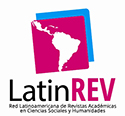Lista de comprobación para la preparación de envíos
Como parte del proceso de envío, los autores/as están obligados a comprobar que su envío cumpla todos los elementos que se muestran a continuación. Se devolverán a los autores/as aquellos envíos que no cumplan estas directrices.- El envío no ha sido publicado previamente ni se ha sometido a consideración por ninguna otra revista (o se ha proporcionado una explicación al respecto en los Comentarios al editor/a).
- El archivo de envío está en formato Microsoft Word.
- Siempre que sea posible, se proporcionan direcciones URL para las referencias.
- El texto reúne las condiciones estilísticas y bibliográficas incluidas en Pautas para el autor/a, en Acerca de la revista.
- El artículo adjunta un documento con la información personal del autor: nombre y apellido; correo electrónico; teléfono de contacto; título académico; área/s de investigación; adscripción institucional -tal como figurará en el artículo, en caso de que sea publicado-; ciudad y país de residencia; y una minibio del autor de hasta 100 palabras, indicando: título máximo alcanzado, institución otorgante del mismo, área de investigación y publicaciones principales.
Declaración de privacidad
Los nombres y las direcciones de correo electrónico introducidos en esta revista se usarán exclusivamente para los fines establecidos en ella y no se proporcionarán a terceros o para su uso con otros fines.








.png)












.png)
.png)
.png)








